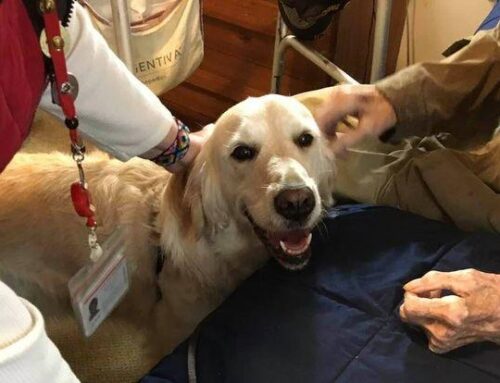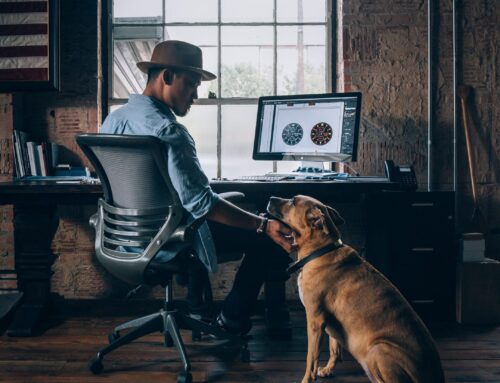Dog Anxiety Symptoms & How To Relieve Them
It’s common for dogs to experience anxiety. Dogs can endure stress when they are in unfamiliar situations or around unfamiliar people. Anxiety can also come from serious circumstances such as abuse or trauma. Anxiety can even happen to therapy dogs on facility visits so it’s important to monitor your dog’s body language for signs of anxiety.
Here are common dog anxiety symptoms to watch out for and how to relieve them.
Potty Accidents
Perhaps one of the most well-known dog anxiety symptoms is potty accidents. When dogs are feeling fearful they can sometimes urinate indoors. This does not mean your dog is behaving badly, it may mean they are anxious. The best thing you can do in this situation is clean up the accident when you notice it and not scold them for urinating where they aren’t supposed to. If you suspect it’s medical-related, you can take your pup to see a veterinarian.
Pacing
Similar to humans, dogs can pace when they feel anxious. If you notice your pup is pacing quite a bit, it could mean they are having trouble getting settled into a situation or are stressed. You can help comfort your pet by reassuring them with calm words and pats.
Panting
Panting is another popular dog anxiety symptom. Most dogs pant when they are feeling hot but they can also pant when they feel anxious or hurt. Have a look at your pet to see if you spot any injuries and lightly pat them. If you are worried they are in pain, you can contact your local veterinarian.
Vocalization
Anxious dogs can become more vocal. For instance, if the owner leaves them home alone for too long they may start barking excessively or whimper in worry. Separation anxiety is common for dogs who are overly dependent on their owners. If you know your dog suffers from separation anxiety, make alternate arrangements to either bring your dog with you on outings or have someone your dog knows stay with them. Also, try to become familiar with your dog’s vocalizations so you can respond appropriately to their needs. Using positive reinforcement techniques is a way to help them remain calm.
Shaking
If your canine shakes like they are wet, it could mean they are trying to shake off stress. Be near enough to them that you can offer comfort if they need it. – But sometimes they just need to shake it off!
Lowered Tail
A dog’s tail can be an indicator of how they are feeling. If their tail is lowered and tense, it could be a sign that they are stressed or fearful. Do your best to identify what may be causing these actions. If the lowered tail leads to other signs of aggression such as growling, you will need to be cautious but also reassuring.
Licking & Gnawing
If your dog seems to be licking themselves more than usual or gnawing at their paw, it could be a sign of anxiousness. Some dogs do this when they are away from their owners for too long. If you notice this behavior, you can reassure your dog with words and affection.
Yawning
If your dog yawns, yes, that may mean they are tired or bored but they could also be feeling anxious. If you are in an unfamiliar setting, do your best to comfort your dog. Watch for signs of your dog’s body language to see if they experience additional anxiety symptoms.
Drooling
Some dog breeds are known to drool more than others but if your pup is slobbering more than usual, particularly in a new place or around new people, it could mean they are anxious. Try to pinpoint why the excessive drooling happens. For instance, if it happens whenever they are in the car, it may mean they are anxious about car rides. If you suspect the excessive drooling is medical-related, you should talk to your veterinarian about it.
How To Relieve Dog Anxiety Symptoms
While reassuring and comforting your pet is one of the top ways to help relieve dog anxiety, here are a few extra suggestions:
Create A Safe Place
Creating a safe environment for your dog can make them feel at ease. This is particularly important if your dog has separation anxiety. Before you leave the home, you can arrange a spot with their favorite toys, blankets, and a rawhide bone for them to chew on. You can also turn on some soothing music or white noise to offer comfort to your pup.
Body Language
Body language is one of the many tells of anxiety in dogs. By understanding your pup’s body language, you can help minimize stress and fearfulness. It’s also important to consider the context of the situation. For instance, if you know your dog doesn’t like fireworks, you will be more aware of the body language and understand why they are acting anxious. Understanding your dog’s body language comes with time and the bond you develop.
Medication
In more severe cases of anxiety, you can talk to a veterinarian about anxiety-relieving medication options. There are also natural alternatives to consider such as valerian or dog-safe essential oils.
Exercise
Taking your dog for a long walk or to the dog park can help with separation anxiety. Getting your dog tired can help them relax easier when you are away from home.
While therapy dogs help us tackle anxiety, it’s important to remember it can affect them too. Offer positive reinforcement and consider your dog’s needs. If you need to reschedule a facility visit, give the venue advance notice if possible.






